Gluten-Free Label Reading
On the evening of Friday, May 22nd 2020, the FDA issued new guidance relaxing the requirements around the labeling of ingredients due to the supply issues caused by the COVID-19 pandemic. As one might expect, this rocked the world of those with food allergies as well as those with gluten-related disorders.
To learn more about this labeling change, check out our article: https://bit.ly/GIGECW-FDA-Temp-Labeling
OK, true confession time. Before 2003 I rarely looked at a product's ingredient label. I saw no point in it; if it tasted good - I ate it. Hmmm, could this have been a contributing factor in my steadily increasing weight and my rapidly declining health? Yeah.

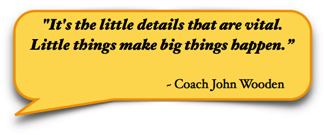
It should be no surprise that attention to detail increases our chances of success in the gluten-free lifestyle. After all, something measured in parts per million rearranges our lives. Talk about little things making big things happen. Coach Wooden’s words take on a whole new meaning for those with a gluten-related disorder.
Knowing what's in our food is probably one of the most important details. President Theodore Roosevelt signed into law the Pure Food and Drugs Act of 1906. Known as the Wiley Act, it gave the federal government the power deem a food “misbranded” if ingredients were “false or misleading,” or deemed “adulterated” if it contained ingredients harmful to health. Sadly, it would take nearly a century before the presence of food allergens would be recognized. A decade later, gluten-free regulations finally make it on the books.
The Protection Agencies
Only a few different governmental agencies regulate food safety. In this article, we’ll be discussing the US Food and Drug Administration (FDA) and the US Dept. of Agriculture (USDA). The US Treasury’s Alcohol and Tobacco Tax and Trade Bureau (TTB) regulates beverage alcohol [as in gluten-free beer]. Sorry beer lovers, we won’t be getting into those regulations in this article.
FDA vs. USDA
The FDA regulates most packaged foods we see on the store shelves. The USDA regulates meat, poultry and egg products, and mixed food products that contain more than three percent raw meat or two percent or more cooked meat or poultry (e.g., soups, chilis, frozen entrees).
While USDA regulated products are encouraged to follow FDA regulations, it is not required. [This is valuable information to know when it comes to reading ingredient lists. More on this later.]
Estimates show that 80% to 90% of USDA products voluntarily comply. If you see a “Contains” statement or other indication of a USDA product, major food allergen will be plainly listed.
FDA & the Top 8 Food Allergens

The FDA’s Food Allergen Labeling and Consumer Protection Act of 2004 (FALCPA) requires food labels to clearly identify the food source names of all major food allergens used to make the food. They must use the common or usual name of an ingredient [e.g., Modified Food Starch (wheat)} or use a “Contains” statement next to the ingredient list. [e.g., Contains Wheat, and Milk]
What are the major allergens as defined by the FDA?
- Milk
- Eggs
- Fish (bass, flounder, cod)
- Crustacean shellfish (crab, lobster, shrimp)
- Tree nuts (almonds, walnuts, pecans)
- Peanuts
- Wheat (including all types: durum, spelt, emmer, farina, farro, einkorn)
- Soybeans
Source FDA: http://bit.ly/FDA-Big8
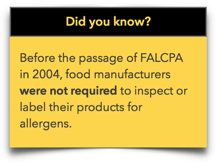
You’ll notice the Top 8 list above only includes wheat. It does not include gluten-containing ingredients barley (malt), rye, or oats*. Fortunately, barley is most commonly listed as “barley," "barley malt," or simply “malt”. Rye is rarely used in a form other than flour and would appear in the ingredient list.
*Oats (and products that contain them) that are not explicitly certified or labeled gluten-free are off-limits to anyone following a gluten-free diet. They are a high-risk ingredient because they are exposed to substantial amounts of gluten via cross-contact from field to packagings. Oats require additional knowledge and careful consideration.
 "What Oats Through Yonder Package Breaks?"
http://bit.ly/GIGECW-PureOats
"What Oats Through Yonder Package Breaks?"
http://bit.ly/GIGECW-PureOats
The Ingredient Label
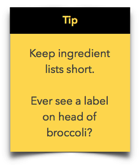
The ingredient label is your frontline defense in determining the gluten-free status of a product. An important fact to know: FALCPA labeling regulations do not apply to the potential or inadvertent presence of food allergens resulting from cross contact. Cross-contamination of a food or ingredient can occur at harvest, transport, manufacturing, or packaging. Calling the manufacturer may be required not only for ingredient clarification but also to determine manufacturing practices.
Cross-contact and Good Manufacturing Practices
Manufacturers are encouraged [not required] to follow Current Good Manufacturing Practices (CGMP). Part of CGMP means developing and executing food allergen control plans. The plan must address six elements: training of processing and supervisory personnel, segregation of food allergens during storage and handling, validated cleaning procedures for food contact equipment, prevention of cross-contact during processing, product label review and label usage and control, and a supplier control program for ingredients and labels.
Voluntary Allergen Advisory Statements
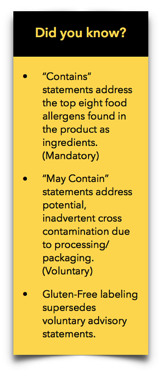
Gluten-free experts and third-party testing tell us Food Allergen Advisory statements are not useful in determining the gluten-free status of a product.
You may find a product labeled “Gluten-Free and/or Wheat-Free” or even bears a GFCO gluten-free certification logo that has a Food Allergen Advisory statement that includes wheat. Yes, this product complies with current FALCPA labeling laws.
For products not certified gluten-free, call the manufacturer to ask questions. Ask about the facilities, the production lines, and their policies, procedures for allergen handling, and testing protocols. If they do not answer the questions to your satisfaction, find another manufacturer with a similar product that does meet your needs.
 "May Contain Statements"
http://bit.ly/GIGECW-MayContain
"May Contain Statements"
http://bit.ly/GIGECW-MayContain
The Definition of Gluten-Free
As we discussed above, FALCPA does not directly address gluten. Before the FDA could create regulations regarding “gluten-free,” they needed to define what “gluten-free” means. It took ten years for the definition to finalize, but the voluntary gluten-free labeling regulation went into effect August 5th, 2014.
The FDA’s definition of “gluten-free,” “no gluten,” “free of gluten,” or “without gluten” is as follows:
“…the food either is inherently gluten free; or does not contain an ingredient that is: 1) a gluten-containing grain (e.g., spelt wheat); 2) derived from a gluten-containing grain that has not been processed to remove gluten (e.g., wheat flour); or 3) derived from a gluten-containing grain that has been processed to remove gluten (e.g., wheat starch), if the use of that ingredient results in the presence of 20 parts per million (ppm) or more gluten in the food. Also, any unavoidable presence of gluten in the food must be less than 20 ppm.”Source: http://bit.ly/FDA-QA-GF-Labeling
Notice the last sentence of the definition: "Also, any unavoidable presence of gluten in the food must be less than 20 ppm.” This means cross-contact.
I hear you…
“Whoa, this is confusing and complicated. Isn't there an App?"
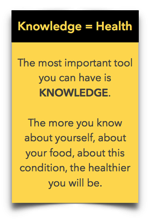
Websites, published lists, and apps that report a product's gluten-free status are excellent tools to help narrow down product selection. Please do not use them as the sole means to determine the gluten-free status.
Companies change product ingredients at will, generally without notice. The product label will reflect any ingredient changes. Most companies will refer you to the ingredient list found on the product for the most up to date information. A published list (on paper or electronic form) is only as accurate as its most recent update.
Reading the label. Finally!
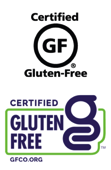
- Look for a third-party gluten-free certification mark - like GFCO's.
- Gluten-Free Certification Organization requires all finished products and individual ingredients using the GFCO logo contain 10 parts per million or less of gluten.
- Know your certification organizations (see logos below). When companies mark their products as GF it may appear as if they are actually certified. It might simply be a logo from their marketing or package design department.
- Read the ingredient list. Yes, even certified products. If you see any of following ingredients, the product is not gluten-free.
- Wheat (including durum, spelt, emmer, farina, farro, einkorn)
- Rye
- Barley
- Oats (unless certified gluten-free)
- Brewer's Yeast
- Malt
- Ingredients needing verification:
- Yeast Extract - this could be a by-product of the beer brewing process. Verify with manufacturer in non-GF labeled products.
- Vinegar - FDA defines the single word "vinegar" to mean apple cider vinegar. However through the certification process, GFCO has encountered some usages of malt vinegar labeled as "vinegar". Remember barley/malt is not required to be disclosed. Not a large area of concern, but if you are unfamiliar with a manufacturer or product, it might be a good idea to inquire about the source of their vinegar. Better safe than sorry.
- USDA Products - Products are not required to comply with FDA's FALCPA regulations. If you see a "Contains" statement (or some other wording) that a package is complying with FALCPA, you know wheat must be declared. If you do not see a "Contains" statement, you'll need to verify the source of these ingredients (they could come from wheat):
- Starch
- Food Starch
- Modified Food Starch
- Dextrin

Congratulations!
You’ve made it! I hope I’ve increased your knowledge on this multi-layered subject.

Label Reading Resources
Gluten-Free Labels 101 Video Webinar
http://bit.ly/GIG-GFLabels101
Q&A Gluten-Free Labels 101 PDF
http://bit.ly/GIG-QA-GFLabels101
Gluten-Free Label Reading
http://bit.ly/GIG-LabelReading
3 Tips for Gluten-Free Label Reading
http://bit.ly/GIG-3TipsGFLabels
Getting Started on a Gluten-Free Diet
http://bit.ly/GIG-GettingStarted
Gluten-Free Certification Organizations and their Logos
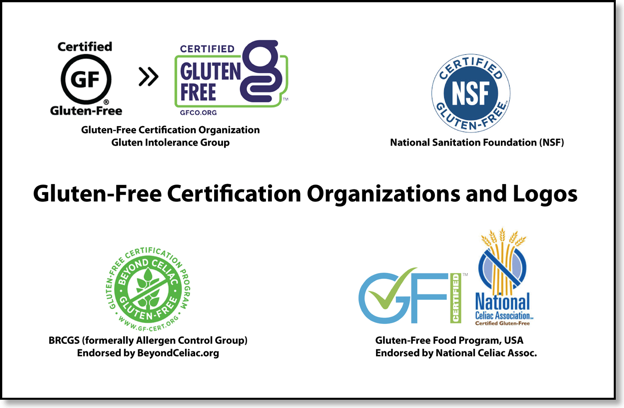

Practical Gastroenterology - December 2019
Timely Topics in Gluten-Free Labeling
NUTRITION ISSUES IN GASTROENTEROLOGY, SERIES #193
By: Amy Keller MS, RDN. LD.
Excellent article from Amy Keller, MS, RDN. LD
“Patients with the inherited autoimmune condition, celiac disease, must avoid gluten in any form to help heal damaged intestinal villi. The Food and Drug Administration’s (FDA) Gluten Free (GF) label is intended to help instill trust in consumers with celiac disease and gluten-related disorders. Studies show that the vast majority of labeled GF foods meet the FDA’s standard of <20 ppm gluten, but consumers remain leery of some labeled GF products, especially those displaying allergen advisory statements for wheat. Products containing malt, malt extract, and other gluten-containing ingredients continue to show up on store shelves, which may indicate that FDA enforcement of the GF labeling rule is lacking. Consumers may find a personal allergen detection tool to be an attractive option to assist in testing food for gluten content, but these also come with significant limitations.”
Read More: https://at.virginia.edu/33RLEqy
In the confusing landscape of food labels, assumptions are risky but knowledge is power.Whether you’re new to the food allergy world or a veteran, there is never a time you can let your guard down. Read More: http://bit.ly/2H3oPW8
Required Reading With Food Allergies or Celiac Disease
By: Gina Clowes
Published: April 1, 2015
Certified master life coach, Gina Clowes offers up some great labeling reading advice.
As many of us who shop for groceries know, gluten can appear in many shapes and forms on a product label. Lots of brands do label their products gluten-free and some even go the extra mile to get a gluten-free certification — but there are still thousands that don’t. So, what does that mean if you have gluten sensitivity or have been diagnosed with celiac disease? Read More: https://bit.ly/3EyMUTo “Let’s face it, the gluten-free diet is complex and difficult to maneuver. Add to this the issue of common ingredients that never seem to get off lengthy lists of “things to question” and it’s no wonder that so many people doing their best to avoid gluten are still assailed by confusion and anxiety. That’s why we think it sometimes makes more sense to explain why you don’t have to worry about certain ingredients. Here are the leading ingredients that you can stop worrying about.” “The information in our ingredients index will help you read a food label. It is based on the research we have done by interviewing experts in the field of food science.”
Gluten-Free Label Reading: From Novice to Expert
Published: March 1, 2022
If you find yourself in the packaged food aisles reading labels, you'll run into some strange and confusing ingredients. You'll need to know what they are and if they are gluten-free. Keep in mind, if the ingredient is gluten-free, it does not mean that it's healthy for you. Choose wisely!
“Top 10 Ingredients you really don't need to worry about”
http://bit.ly/2Dn9z7m
“Ingredient Index”
http://bit.ly/2Te1JTm
Updates:
4/21/22 - Add Gluten-Free Living’s link
04/12/21 - Add updated GFCO logo and GF certification organizations and their logos
06/20/20 - Added link to FDA’s Temporary Labeling Guidance.
12/5/19 - Added Practical Gastro Article from Amy Keller MS, RDN. LD.
11/14/18 - Added Confusing Ingredients
04/15/18 - Added AllergicLiving.com article from Gina Clowes